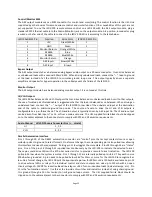
Page 60
Appendix E – INI File Formats
Many configuration files used by the JSD-100 GUI are plain text ini files. They are located in My
Documents\USL\JSD-100 and its subdirectories. These files can be edited with a standard text editor to change the
operation of the system. This appendix shows the typical contents of these files. Note that the file contents are
described in comments (where a line starts with #).
AutoEQ.ini
# This is the initial state for starting automatic EQ.
# Settling - Specifies the amount of time in seconds to wait
# before taking a first time SPL reading.
# QuietLevel - This is the upper limit to determine no background
# noise in the auditorium is present.
# ChannelGain - This is the initial starting point for setting the
# starting channel trim level, it must be low enough that with a fader
# level the output SPL in low enough to continue with auto EQ.
# Fader - This is the output fader level setting, trims are used to adjust
# the level.
# EQSPL - Is used for the initial sound level and the level for automatic EQ.
# Decay - The RTA setting for controlling the update rates.
[Initialize]
Settling=3.0
QuietLevel=60.0
ChannelGain=-20.0
Fader=7.0
EQSPL=80.0
Decay=100
# This state is used for setting up the settings prior to running
# the automatic EQ procedure. An average is created within a valid
# range of the distribution, the Mode. The Mode is a reference
# level that is used to set the gains for the desired SPL for a
# given speaker location.
# StageSPL - Level for stage speakers to be automatically EQ'ed.
# SurroundSPL - Level for surround speakers to be automatically EQ'ed.
# Maximum && Minimum - The upper and lower limits for channels being
# sampled and to be used for generating the current average, Mode.
# Samples - The number of passes to calculate the mode within a valid
# distribution of RTA band samples.
# Settling - Amount of time to wait between updating the average mean, mode.
[Normalize]
StageSPL=85.0
SurroundSPL=83.0
Maximum=10.0
Minimum=-10.0
Samples=3
Settling=0.5
# When the automatic EQ process is running, there is a
# count for the number of passes. With each pass the EQ's are updated.
# With each pass, after a number of passes, the amount of change between
# the current and last EQ setting is then used to determine if the automatic
# EQ processing is complete.









































